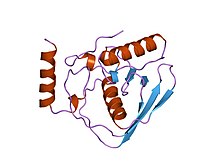| Peptide deformylase | |||||||||
|---|---|---|---|---|---|---|---|---|---|
 Escherichia coli peptide deformylase structure | |||||||||
| Identifiers | |||||||||
| EC no. | 3.5.1.88 | ||||||||
| Databases | |||||||||
| IntEnz | IntEnz view | ||||||||
| BRENDA | BRENDA entry | ||||||||
| ExPASy | NiceZyme view | ||||||||
| KEGG | KEGG entry | ||||||||
| MetaCyc | metabolic pathway | ||||||||
| PRIAM | profile | ||||||||
| PDB structures | RCSB PDB PDBe PDBsum | ||||||||
| Gene Ontology | AmiGO / QuickGO | ||||||||
| |||||||||
In enzymology, a peptide deformylase (EC 3.5.1.88) is an enzyme that removes the formyl group from the N terminus of nascent polypeptide chains in eubacteria, mitochondria and chloroplasts.[1]
Peptide deformylases are metaloenzymes monomers and bind a metal cofactor, typically Fe(II) or Zn, in an active site. Cofactor identity impacts catalytic efficiency.[2]
There are two types of peptide deformylases, types I and II, which differ in structure mainly in the outer surface of the protein.
Human gene PDF (gene) possesses this activity.
- ^ Escobar-Alvarez S, Goldgur Y, Yang G, Ouerfelli O, Li Y, Scheinberg DA (April 2009). "Structure and activity of human mitochondrial peptide deformylase, a novel cancer target". Journal of Molecular Biology. 387 (5): 1211–1228. doi:10.1016/j.jmb.2009.02.032. PMC 2782631. PMID 19236878.
- ^ Becker A, Schlichting I, Kabsch W, Schultz S, Wagner AF (May 1998). "Structure of peptide deformylase and identification of the substrate binding site". The Journal of Biological Chemistry. 273 (19): 11413–11416. doi:10.1074/jbc.273.19.11413. PMID 9565550.